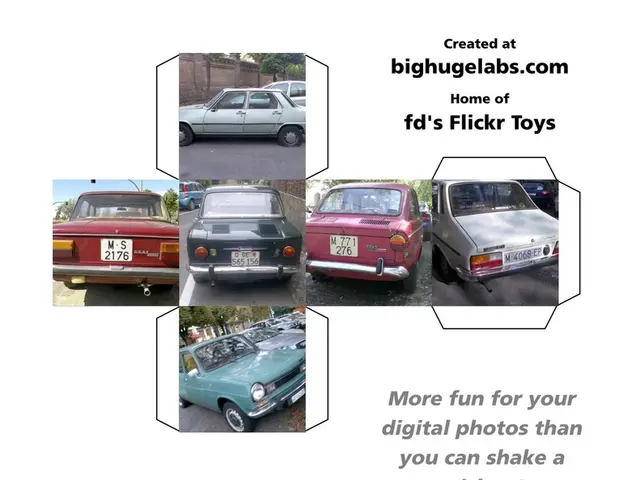Developing Sellable Garments: Ten Clothing Design Strategies Confirmed Effective
Unlock the secrets of clothing design and learn how to create stunning, sellable outfits! Whether you're a budding designer or a dedicated fashion enthusiast, this guide covers the essentials of garment design and production. We'll delve into the basic principles and components that make every piece of clothing unique and eye-catching.
But that's not all! We'll also unravel the mysteries of fashion, teaching you how to work fashion magic. Ready to master clothing design and level up your wardrobe game? Let's dive in!
The Essential Building Blocks of Clothes Design
Nailing the fundamental elements of clothes design is key to creating visually appealing and unique garments. Fashion designers are taught to take into account five major components to create eye-catching and distinctive clothing:
- Shape and Form: The contours and silhouette that give clothes structure.
- Line: Lines define forms and shapes and help guide the eye when an object or garment is worn.
- Color: The use of color to enhance and complement the design.
- Texture: The tactile feel and visual effect textures have on the wearer.
- Space: The spatial relationships between forms and shapes in a garment.
In addition to these components, designers also follow five basic principles:
- Proportion and Scale: Balancing the various parts of a garment so they appear harmonious.
- Balance: Creating visual equilibrium through the organization of a garment's components.
- Unity (Harmony): Ensuring that all elements of a design work together in a cohesive way.
- Rhythm: Using repeated design elements to create visual movement and energy.
- Emphasis: Focusing attention on specific design elements to create a focal point.
Component Breakdown
Line:
Lines create the impression of length and width in a design. Combining lines defines forms and shapes and encloses space. Different types of lines, such as horizontal, vertical, oblique, diagonal, and curved, produce unique impacts on a garment. Lines can help minimize or emphasize specific body types and create a balanced or unbalanced appearance.
Shape and Form:
The human body is a form that takes on different shapes when viewed from various angles. Clothes visually alter the body, especially during fashion shifts. The garment's shape can be influenced by factors like fit, silhouette, and drape. Shapes can be raglan, flared, circular, or straight, and they can gradually change or appear suddenly. A loose-fitting shape is more likely to be accepted and last for an extended period, while a tight fit is generally meant for ideal figures.
Space:
Space refers to the empty area around or within a form. Real depth can't be achieved on a flat surface, but the illusion of depth can be created through various techniques.
Texture:
The fabric's feel, drape, and stiffness or softness greatly impact the way it appears on a garment. Additionally, texture provides a visual effect on the wearer.
Color:
Color is crucial in design, shaping first impressions and influencing overall perception. Current color trends should be considered when designing clothes, as they help stimulate creativity and offer fresh perspectives on existing designs. Color also plays a significant part in corporate identity. Using extreme caution is essential when selecting colors because they can either strengthen or weaken an appearance.
Principle Breakdown
Proportion and Scale:
The harmonious relationship between the various parts of a design in terms of size, color, and quantity is referred to as proportion. The proportion between various elements, like the size of an object compared to others in a composition, should be accurate for a visually pleasing design.
Balance:
Visual equilibrium is achieved when opposing forces in a composition create stability. Balance refers to the overall stability and appropriate placement of components within a garment. A well-balanced outfit creates visual harmony.
Unity (Harmony):
Unity, or harmony, is the cohesive relationship between elements in a design that contributes to a complete and seamless appearance.
Rhythm:
Rhythm is created by employing repeated design components that suggest ordered movement. Rhythm can evoke emotions, much like music or dance. Introducing variety in rhythm keeps it engaging and dynamic.
Emphasis:
Emphasis focuses attention on a specific design feature. This is often accomplished by using contrast to visually separate an area from others. Different techniques for emphasis include using value (light and dark), complementary colors, atmospheric perspective, and allegory.
Designing Clothes That Sell Like Hotcakes
1. Know Your Audience:
Before designing clothes, gather insights about your target demographic, including age, gender, location, lifestyle, and fashion preferences. Understanding their needs and challenges will guide your design choices, especially when it comes to activewear.
2. Stay In the Know:
Stay updated on the latest fashion trends, additional resources, and industry news through fashion magazines, websites, blogs, attending fashion shows, and following fashion influencers on social media platforms like Instagram and Pinterest.
3. Select the Right Fabrics and Materials:
Different fabrics have unique properties. Understanding the fabric's characteristics and how they work will help you create beautiful and effective garments. Prioritize fabrics that can withstand damage, washing, and environmental conditions, and choose materials that align with your brand's values.
4. Pay Attention to Detail and Quality:
Ensure that your lines are perfect, borders are well-finished, and decorative elements are securely attached. High-quality artwork enhances the overall look and durability of your design.
5. Craft a Strong Brand Identity:
Develop a compelling brand statement that highlights your design philosophy, unique style, and differentiating factors. Share your journey, inspiration, and values through messaging and visuals.
6. Focus on Functionality and Comfort:
Create clothing that fits well, looks great on different body types, and is comfortable to wear for extended periods. Offer a variety of sizes, extra sizes, and inclusive sizing options to expand your customer base.
7. Embrace Sustainable Practices:
Opt for eco-friendly fabrics, such as organic cotton, bamboo, and recycled fabrics, and prioritize sustainable and ethical production methods. Reduce your environmental footprint by minimizing waste and using recycled or upcycled materials.
8. Limit Your Product Assortment:
Concentrate on designing a single category, such as dresses, jackets, or accessories. Specializing in a specific area allows you to become an expert and create a niche in the market.
9. Develop Effective Marketing Strategies:
Effective marketing is vital for reaching your target audience and building brand awareness. Utilize platforms like Instagram, Facebook, and Pinterest to showcase your designs and engage with your community. Create a user-friendly e-commerce website and provide informative, engaging content about fashion trends, your brand, and inspiration.
10. Prioritize Branding and Storytelling:
Share the journey, values, and passions that inspired your creative process through your brand identity, messaging, and visuals. Build an emotional connection with your audience by sharing relatable stories and values that resonate with them.
Are You Ready to Design Clothing Lines That WOW Customers?
partners with expert manufacturers to turn your fashion dreams into reality! Get a Free Quote today!
Becoming a Successful Clothing Designer
Becoming a successful clothing designer requires creativity, technical skills, and a deep understanding of the industry. Here are some tips to improve your skills as a designer:
- Develop your design skills by creating clothing designs, sketches, and project mockups.
- Learn the basics of sewing to translate your designs into physical garments.
- Pursue formal education or take fashion design courses to master techniques like pattern making, draping, and garment construction.
- Build a strong portfolio that highlights your best work, including project documentation, finished designs, and illustrations.
- Intern or work in the fashion industry to gain real-world experience and learn from experts in the field.
- Embrace technology by utilizing design tools like Adobe Illustrator and design software specifically for fashion design to create professional patterns and designs.
- Develop your unique style by drawing inspiration from various sources, such as art, architecture, nature, and other designers.
- Seek feedback and critique from mentors, colleagues, and potential clients to improve your designs and refine your skills.
- Start small and gradually build your brand identity, portfolio, and network.
Wrapping Up!
From the basics of design principles to understanding the clothing production process, this guide has equipped you with the tools necessary for creating stunning, eye-catching garments. Let creativity flow, passion spark, and your brand identity shine through as you venture into the exciting world of fashion design!
For individuals passionate about fashion and looking to expand their knowledge beyond clothing design, there's an extensive opportunity in the realm of education and self-development. Delve into the world of fashion education, where you can learn about the industry's latest trends, growth strategies, and marketing techniques. By expanding your skillset, you can develop a comprehensive understanding of the industry and elevate your fashion business to new heights (education-and-self-development).
Moreover, the realm of lifestyle extends beyond clothing design, encompassing numerous aspects that contribute to the overall aesthetic and well-being of an individual. To complement your newfound knowledge in fashion, consider exploring the ever-evolving market of fashion-and-beauty. Discover products and tips that will enable you to elevate your appearance and enhance your confidence.








